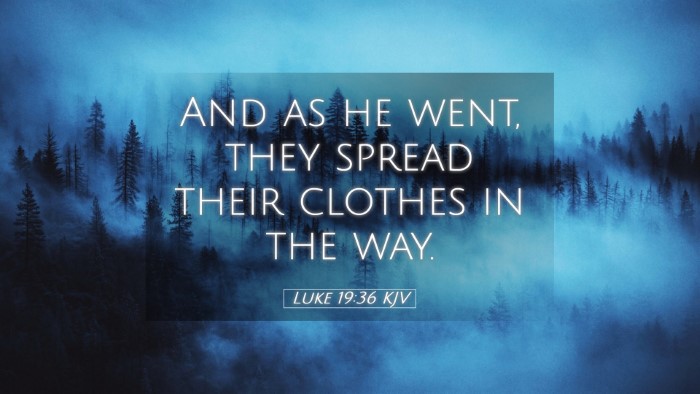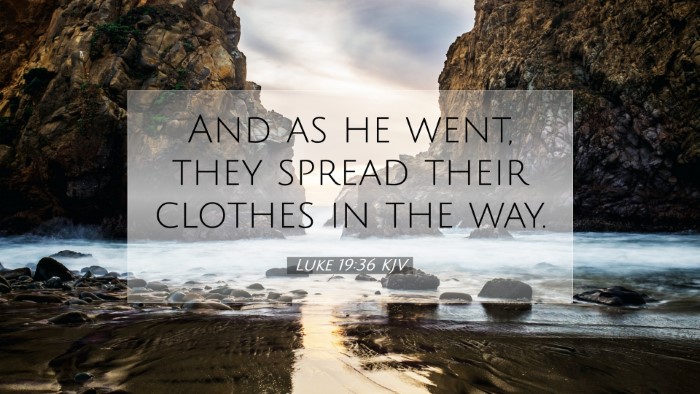Commentary on Luke 19:36
Luke 19:36 states, "And as he went, they spread their clothes in the way." This verse is part of the narrative of Jesus' triumphal entry into Jerusalem, a pivotal moment that signifies His messianic identity and the fulfillment of prophecies regarding the coming King.
Contextual Background
The events leading up to this moment are essential for understanding its significance. Jesus is approaching Jerusalem, where He will soon face crucifixion. His journey to the city, marked by teaching and miracles, culminates in this enthusiastic reception by the crowd. The act of spreading clothes before Him is emblematic of honor and recognition, as seen in ancient Near Eastern customs.
Insights from Matthew Henry
Matthew Henry comments on this verse by underscoring the crowd's enthusiasm and the significance of their actions. He notes:
- Symbol of Honor: Spreading garments on the road was a customary way to receive royalty. This act indicates the recognition of Jesus' kingly authority, even if the full understanding of His mission remained limited.
- Fulfillment of Prophecy: Henry brings to light the prophetic implications of this event, connecting it to Zechariah 9:9, which speaks of the king coming humbly on a donkey. This connection highlights the anticipated arrival of the Messiah as foretold by the prophets.
- The People’s Expectation: The crowd's actions reflect their hopes for political deliverance from Roman oppression, viewing Jesus primarily as a temporal savior.
Insights from Albert Barnes
Albert Barnes, in his commentary, approaches this passage with additional depth concerning the significance of the crowd's actions:
- Public Acclaim: He emphasizes the public nature of Jesus’ entry. The act of spreading garments suggests an open acknowledgment of Jesus as the Messiah, even if their expectations were incomplete.
- Indication of Leadership: Barnes points out that this episode demonstrates how leaders are often met with public demonstration of support, which in this situation reflects the people's longing for a deliverer.
- The Juxtaposition of Praise and Rejection: Barnes also notes the irony present in this moment—while the crowd shouts praises, they would soon turn away when faced with the reality of Jesus' sacrificial mission.
Insights from Adam Clarke
Adam Clarke adds further dimension by exploring the cultural implications of this act:
- Cultural Significance: Clarke delves into the cultural context, noting that laying down garments was a sign of respect that went beyond mere celebration; it indicated submission to authority.
- The Nature of Jesus' Kingship: He highlights that the manner of Jesus' entry—riding on a donkey—was an intentional choice that contrasted the expected image of a powerful conqueror, reinforcing His radical approach to leadership and authority.
- Spiritual Insight: Clarke reflects on the spiritual significance of the garments as a metaphor for laying down one's life and will before Christ, a call for humility and reverence in His presence.
Theological Reflections
This verse, along with its associated actions, stirs several theological reflections worthy of consideration for pastors, students, and scholars:
- Messianic Fulfillment: The triumphal entry is a clear testament to Jesus' fulfillment of messianic prophecies, reinforcing the biblical narrative of God's plan for redemption.
- Public Witness: The crowd's public demonstration encourages modern-day believers to consider their own responses to Jesus, both in personal faith and corporate worship.
- Understanding Christ's Mission: The contrast between the crowd's expectation of a temporal king and Jesus' broader mission of spiritual salvation invites deeper exploration of how contemporary Christians receive and represent Christ today.
- Call to Worship: The act of spreading garments represents an invitation to believers to offer their lives and resources in worship and service to Christ.
Conclusion
In summary, Luke 19:36 encapsulates a moment of great significance, illustrating the juxtaposition of public praise and misunderstanding of Jesus' mission. Insights from Matthew Henry, Albert Barnes, and Adam Clarke offer a multifaceted view that challenges readers to reflect on their own understanding of Christ as King and Savior. As believers engage with this scripture, they are called to consider not only the adoration displayed by the crowd but also the depth of commitment and understanding that Jesus' kingship demands of them.


